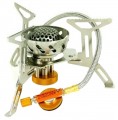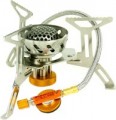Fuel consumption
The amount of fuel required for the normal operation of the burner for a certain time; usually stated in grams per hour. Different manufacturers may calculate fuel consumption differently, but most often it is indicated for normal operation, when the burner produces the power indicated in the documentation (see "Power"). Knowing the fuel consumption and the capacity of the cylinder used (see "Replaceable cylinders") or the built-in tank (see "Filling volume"), you can easily calculate the time of continuous operation of the burner.
Continuous operation time
The time that the burner is able to work without changing the cylinder or refilling the tank. Usually, the characteristics indicate the operating time at maximum power (see above); at lower power, the actual operating time may be longer than stated. However, it is best to evaluate and compare different models by directly claimed battery life.
Another important nuance is that battery life directly depends on the volume of the fuel tank — and many modern burners are designed for interchangeable cylinders produced in different volumes. Therefore, the characteristics may indicate for which cylinder model the continuous operation time is given (and for
multi -fuel models, the type of fuel should also be specified). If there are no such data, the tank capacity required for a certain time can be calculated from fuel consumption: for example, gas consumption of 180 g / h and battery life of 120 min (2 h) mean that the data are given for a cylinder of at least 360 g (400 mL) gas. With other volumes, the time of continuous operation will differ accordingly.
Preheating
Availability in a torch of function of
preliminary heating of fuel. In such models, the fuel supply system is designed in such a way that the burner flame slightly heats the fuel line during operation.
This function somewhat complicates the design and increases its cost, but increases efficiency and reduces fuel consumption. The presence of preheating is especially important if the device is planned to be used in the cold and/or in high altitude conditions. Under such conditions, the gas pressure at the outlet of the cylinder drops significantly, and liquid fuel can become viscous; both have a negative effect on power and efficiency, while heating allows you to compensate for these phenomena.
Replaceable balloons
Models of cylinders for the use of which the burner is structurally designed. Usually, the cylinders specified in the specifications are guaranteed to be compatible with the burner in the standard configuration — up to the point that for models equipped with adapters for different types of fasteners (for example, from thread to collet, see "Cylinder Mount"), this paragraph often indicates both regular and "non-native" cylinders.
Knowing the names of the cylinders, you can easily find fuel for the burner in specialized stores.
Material
—
Titan. Durable, wear-resistant and light weight material, characterized by high resistance to corrosion and resistance to high temperatures. Burners in a titanium alloy body make ammunition as light as possible in comparison with models made of other metals, which is extremely important when hiking.
— Steel. The stainless steel body guarantees a long service life of the burner due to its high resistance to corrosion. Steel also tolerates high temperatures well.

